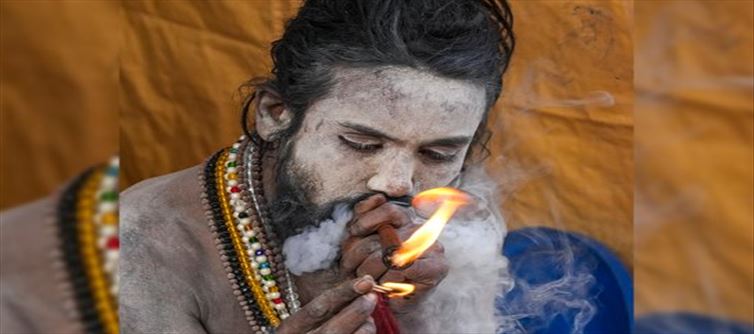
hinduism, with its centuries-old culture and diverse spiritual practices, has often prided itself on being a tolerant, peaceful, and inclusive tradition. However, in recent years, a disturbing trend seems to be emerging: the rise of the naga Sadhus, a group of ascetics known for their fierce defense of hinduism, even when confronted with challenges that many believe should be met with silence and introspection. While their existence is not new, the growing prominence of their forceful responses to criticism of Hindu practices has raised questions about the future of hinduism and its relationship with modern society.
The naga Sadhus: Guardians of tradition, or Guardians of Ego?
naga Sadhus, traditionally silent in their spiritual pursuits, have long been symbols of asceticism, renouncing worldly pleasures to devote their lives to the worship of Lord Shiva. They are usually characterized by their deep meditation and solitary existence, often living at the edges of society, far removed from the chaos of everyday life. However, their role in society has begun to shift. As hinduism faces increasing scrutiny and criticism, particularly in the context of modernity, naga Sadhus have increasingly stepped into the limelight, defending Hindu practices in ways that seem to contradict the very essence of their existence.
The naga Sadhus’ role in spiritual matters was once limited to the quiet and personal pursuit of divine truth. Now, their public presence and readiness to confront opponents of hinduism appear to have become more about assertion of power and dominance rather than spiritual enlightenment. In many cases, their responses to criticism of Hindu rituals or beliefs, such as the MahaKumbh Mela, seem to have transformed from spiritual wisdom to a fierce and sometimes hostile defense of pride and tradition.
Provoked by Criticism: A Dangerous Precedent
The rise of the naga Sadhus into public discourse has been provoked by growing criticism of hinduism, especially from more progressive thinkers and modern reformers. While some of this criticism may be harsh or unfounded, it has often come from individuals who believe that certain practices, rituals, or ideas within hinduism need to evolve to remain relevant in today's world. From questioning superstitions tied to certain events like the MahaKumbh, to challenging outdated social customs, there has been a shift towards reevaluating long-held traditions.
However, instead of fostering an environment of dialogue and self-reflection, these provocations seem to have brought about an aggressive response from the naga Sadhus. Their involvement in confrontations with critics – particularly those who are questioning or opposing aspects of Hindu practices – can be seen as a troubling departure from the peaceful, introspective ideals that hinduism once championed.
Rather than seeking a peaceful resolution or engaging in intellectual debates, the naga Sadhus’ responses have often turned into hostile actions that seem more concerned with protecting a perception of Hindu superiority than with embracing modern interpretations of spirituality. This has led to the disturbing possibility that the Hindu tradition, instead of evolving with the times, is instead doubling down on rigid beliefs that may be out of touch with contemporary reality.
The Dangers of Religious Intolerance: A Growing Divide
What has been particularly concerning in this shift is the underlying tone of intolerance that has emerged from some of these encounters. In many instances, those critical of hinduism have been met not with reason or calm, but with anger, intimidation, and even violence from those who claim to protect Hindu culture. While the naga Sadhus may see themselves as defenders of tradition, their actions risk alienating a growing number of people who are calling for hinduism to adapt to modern principles of equality, reason, and tolerance.
This rise of aggressive naga Sadhu rhetoric is a reflection of a larger issue facing hinduism today: the increasing influence of religious fundamentalism. Instead of embracing the flexibility that hinduism has historically afforded, these groups seem intent on rigidly adhering to a vision of the religion that is not only hostile to outside criticism but also resistant to change.
The Need for Reflection and Change
hinduism, at its core, has always been about the search for truth, spiritual awakening, and the acceptance of diverse paths to liberation. The peaceful and contemplative silence of the naga Sadhus once symbolized this introspective journey, suggesting that true wisdom came from within. However, by taking a more combative approach in the public eye, the naga Sadhus risk distorting the very spirit of hinduism – turning it from a philosophy of peaceful coexistence to one of opposition and exclusion.
Rather than reacting defensively and aggressively to every provocation, perhaps the time has come for a period of self-reflection within the Hindu community. The world is changing, and hinduism must also adapt, embracing a vision of spirituality that is open-minded, inclusive, and in tune with the needs of modern society. By fostering peaceful dialogue and reevaluating certain practices, hinduism can remain relevant without feeling threatened by criticism.
Conclusion: A Call for a More Reflective Hinduism
The rise of the naga Sadhus in response to criticism represents a troubling shift in the Hindu community. What was once a silent, introspective tradition has become increasingly reactive and defensive. This trend risks turning hinduism into a religion of rigid orthodoxy rather than a path of spiritual freedom and enlightenment. It is time for the Hindu community to reflect on its past, embrace modern values of tolerance and understanding, and ensure that it continues to grow as a religion that can thrive in a pluralistic world, free from the constraints of defensiveness and hostility.




 click and follow Indiaherald WhatsApp channel
click and follow Indiaherald WhatsApp channel